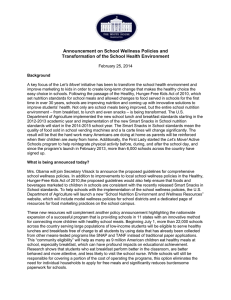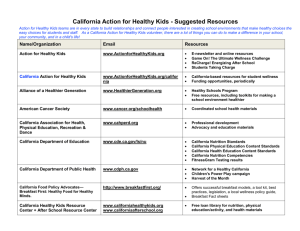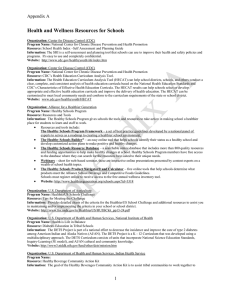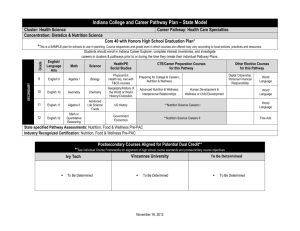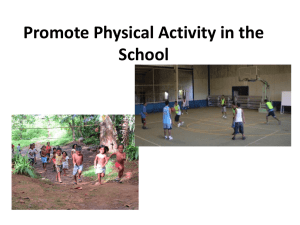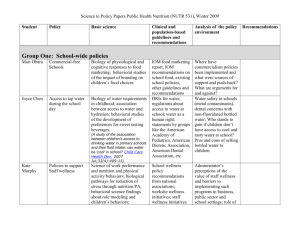Wellness Impact Slide Presentation for Schools
advertisement
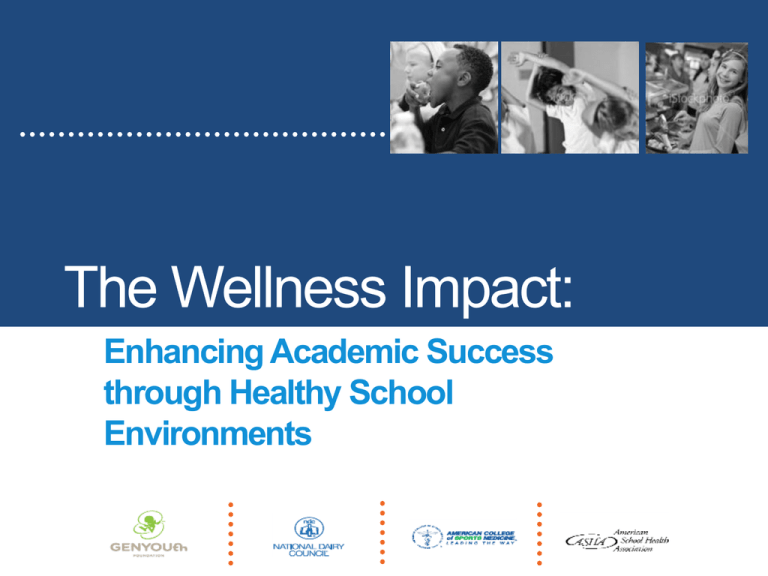
The Wellness Impact: Enhancing Academic Success through Healthy School Environments Overview • Today’s environment • Connections between nutrition, physical activity and the brain. • Schools’ role more important than ever • Barriers • What can be done Over 22% of children live in food-insecure homes Almost one-third of youth ages 2-19 are overweight or obese Overweight or Obese Children Are at Risk for Conditions such as: • High Cholesterol • Type 2 Diabetes • High Blood Pressure • Social Problems and Poor Self-Esteem • Sleep Disturbances • Orthopedic Problems Each Helps the Other HIGHER ACADEMIC ACHIEVEMENT POSITIVE HEALTH BEHAVIORS Schools can help. Nutrition results are in New What you eat or don’t eat matters to your brain Benefits of Breakfast at School Fewer disciplinary referrals Improved attendance Breakfast Comes in Many Forms Physical Activity Matters to Your Brain, Too • Exercise increases brain activity – even just a short 20-minute walk • Other research shows obesity may have negative effects on thinking Brain Studies Suggest Association • Physical activity may positively impact academic achievement • Some research indicates brains of aerobically fit children show superior executive brain functions • Some research indicates benefits include better attention and improved math and reading scores School-based Physical Activity and Academic Achievement CDC assessment of schoolbased activity and achievement found: • Using school time for PE does not hurt academic performance • There is a lot of evidence that shows school-based physical activity can: • Improve grades and standardized test scores • Help students have better attitudes toward school and academic behavior Physical Activity In the Classroom - Adding activity breaks to class time can improve performance without disrupting learning time - Students were more active when teachers participated in activities, too - Students who were more active improved academically more than students who were not Common Barriers to Wellness • Lack of: • Time • Money • Support • Wellness not a priority • Need for tools and training What We Can Do • Take a leadership role in setting tone and vision for healthy schools • Let more people know about the link between nutrition, physical activity and achievement • Establish a wellness council and create a strong wellness policy • Involve students! • Track and share progress and results Specific Action Ideas • Expand school breakfast, and offer alternative breakfast opportunities at school • Make sure all food served and sold at school is appealing and nutritious – and promote healthy choices to all students • Offer high quality P.E. to all students in all grades • Provide a variety of physical activity opportunities, like dance clubs, walking clubs and in-class physical activity breaks for all students Resources FuelUpToPlay60.com • Build schools’ capacity for implementing wellness policies • Places students at the forefront in helping to make and participate in healthy changes • Developed by National Dairy Council and National Football League in collaboration with USDA and other organizations www.genyouthfoundation.org Let’s Move www.letsmove.gov Presidential Youth Fitness Program www.pyfp.org Breakfast in the Classroom Resource Center docs.schoolnutrition.org/SNF/BIC/ USDA Team Nutrition http://www.fns.usda.gov/tn HealthierUS School Challenge www.fns.usda.gov/tn/healthierus/ index.html CDC: School Health Index and Other Resources www.cdc.gov/healthyyouth/shi/




